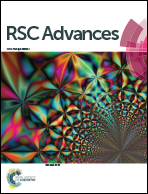Combining microfluidic devices with coarse capillaries to reduce the size of monodisperse microbubbles†
Abstract
In this work we report a significant advance for the preparation of monodispersed microbubbles, which are increasingly used and have become a key constituent in many advanced technologies. A new device comprising of two T-junctions containing coarse capillaries and operating in series was assembled. Microbubble generation was facilitated by using bovine serum albumin solution and nitrogen as the liquid and the gas phase, respectively. The effect of operating parameters such as gas pressure and liquid flow rate on the size of the microbubbles generated were investigated for the two T-junction systems and the results were compared with a single T-junction process. The experimental results showed that microbubbles produced via the double T-junction setup were smaller at any given gas pressure for both liquid flow rates of 100 and 200 μm studied in this work. A predictive model is developed from the experimental data, and the number of T-junctions was incorporated into this scaling model. It was demonstrated that the diameter of the monodisperse microbubbles generated can be tailored using multiple T-junctions while the operating parameters such as gas pressure and liquid flow rates were kept constant. The stability of the microbubbles produced was also examined and indicated that microbubbles produced through the double T-junction were more stable.


 Please wait while we load your content...
Please wait while we load your content...